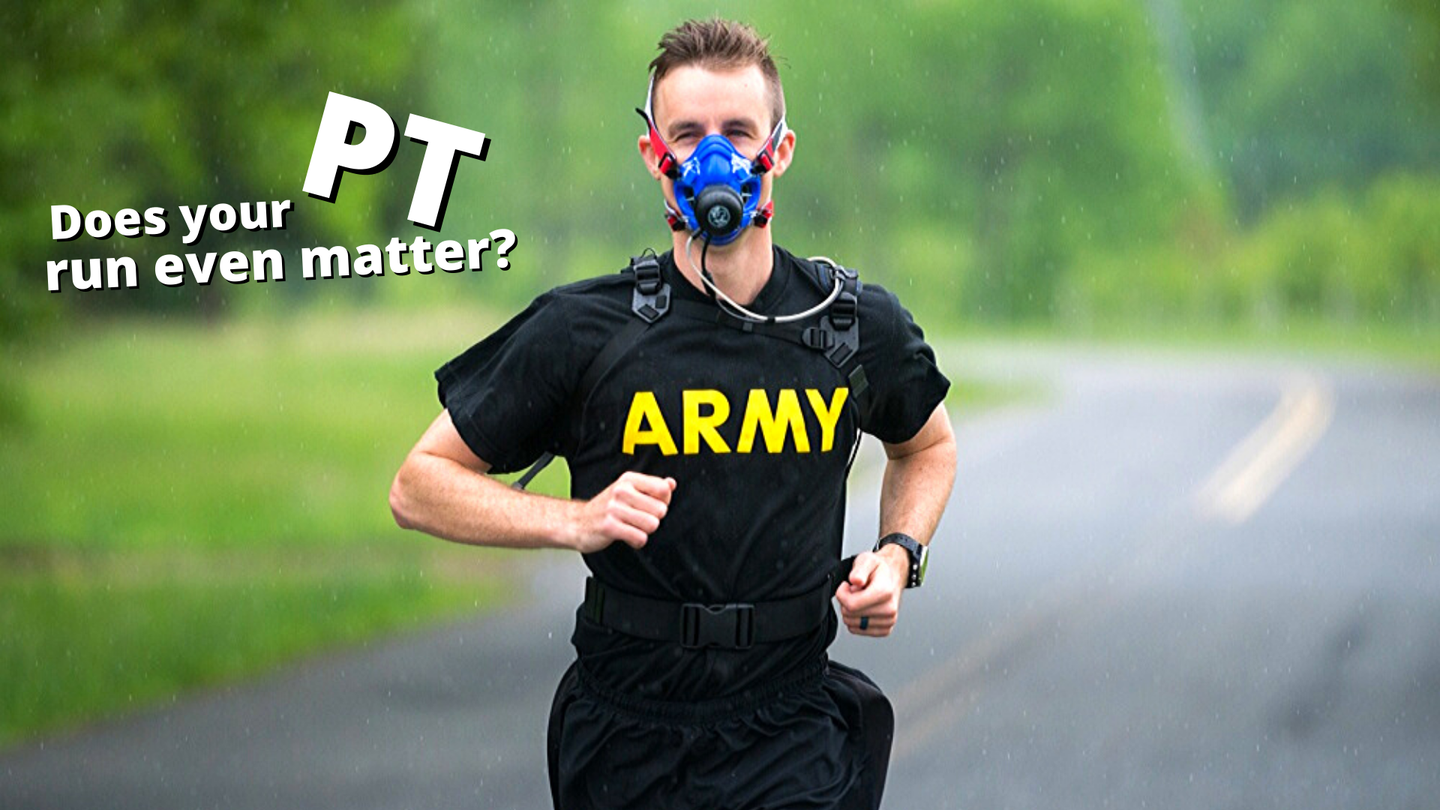Does your PT run even matter?

SUMMARY
I used to think the distance run in the Marine Corps PT test was BS, antiquated, and pretty useless. Seriously, how the hell was a 3 mile run in go-fasters supposed to prove that I would be able to operate in combat with a full kit of more than 50 lbs of gear?
What does the distance run even measure, and is that actually relevant to the demands of the job of someone expected to perform in combat? Is aerobic fitness really what we think it is? Should the same standard be expected of all service members?
(U.S. Navy photo by Mass Communication Specialist 3rd Class Joe Boggio)
What the test measures.
The distance run on the military PT tests is "designed" to measure aerobic endurance and by proxy cardiovascular health.
Aerobic endurance is more difficult to measure than you think though. The faster you run, the more energy you need to fuel that running. That means your body needs to be more efficient at using oxygen to create energy, since that's what aerobic exercise actually is, movement fueled using oxygen.
If your body isn't used to using oxygen to create fuel to run at a certain intensity, it will begin to switch over to anaerobic respiration. Anaerobic respiration occurs when you're running so fast that the body can't adequately use oxygen to make fuel. That's what the "an" in anaerobic means: 'without' oxygen.
You know you are in the aerobic zone if you can still speak in short sentences while running, AKA, the talk test. You're in the anaerobic zone if you can't. Pretty simple right?
Using this logic, a PT 'distance' run that requires you to run so hard that you can't speak at all, let alone in short sentences, is not a test of aerobic endurance. It's a test of anaerobic endurance and lactate threshold.
A true test of aerobic endurance would be something like a run that measures heart rate or administers a talk test periodically to see when someone switches from aerobic to anaerobic. Something similar to what doctors do when testing heart rate variability.
(U.S. Army photo by Pfc. Carlie Lopez)
How does this translate to real life?
The main thing that aerobic endurance tells us is the efficiency of the heart at getting oxygen into the bloodstream so that it can be used to make energy. We find that level of cardiovascular fitness at the aerobic threshold. This is a very important thing to measure, especially in a world where cardiovascular disease is the #1 cause of death.
From the aerobic threshold on the run is showing how much lactate a person can handle. The body's ability to handle that burning feeling in the muscles that occurs when you're in an anaerobic state is very important. That's what the 880m run in the USMC CFT measures as well as the Sprint-Drag-Carry in the Army CFT. Will someone have to move many miles as fast as possible in a combat scenario? Most definitely. Will they ever have to do that same thing in go-fasters and silkies? That's doubtful.
The mere fact that the PT run isn't done in boots means that it doesn't translate very well to job-specific tasks. Especially for troops that are expected to be combat ready.
The expectation is entirely different for those that work in an office all the time and will never be expected to go to combat. For those troops, aerobic endurance is more important since cardiovascular disease is more likely to kill them than incoming mortar fire (that you may need to run away from as anaerobically quickly as possible.)
(Photo by Lance Cpl. Shane Manson)
Use the test to measure what you need to train.
Which category do you fall in? Combat or non-combat?
The answer to that question should dictate how you train for the distance run portion of your PT test.
If you're training for combat, get great at operating in a high-stress, more anaerobically dominated environment in a full combat kit.
If you're training to not die from heart disease train to up your aerobic threshold to make your heart better at pumping oxygen.
TO ANSWER THE HEADLINE QUESTION: Yes, your PT run matters; it just depends on how.
Even though all members of the DOD have vowed to protect the country, that doesn't mean every member will be doing that in the same exact way. For that reason, it's foolish to expect everyone to train the same way with the same end in sight.
If you're trying to figure out how to train in order to get better at your job or just get healthier check out the Mighty Fit Plan!
If you want me to explore some other element of training, fitness, or nutrition, let me know in the Mighty Fit Facebook Group.
If you have a more personal inquiry feel free to shoot me a direct email to michael@composurefitness.com
SHARE
